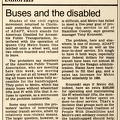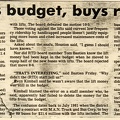Denver Post
[This article continues on in ADAPT 123, but the entire text is included here for easier reading.]
Photo by Lyn Alweis: A short haired man in a jacket and dark slacks [Mel Conrardy] is lifted in his wheelchair from the sidewalk to a bus. The lift comes out of the front door of the bus and has railings on either side of the lift almost as tall as the seated man. Just by the bus door is a sign on the side of the bus that says "RTD Welcome Aboard."
Caption: An RTD bus with wheelchair lift provides mobility for Mel Conrardy
Title: Leaders of handicapped rate RTD service best in country
By Norm Udevitz, Denver Post Staff Writer
Disabled Denverites just a few years ago had as much chance of riding a bus as they did of climbing Mount Everest.
“It was brutal the way RTD treated us,” said Mike Auberger, an official in the Atlantis Community, for the disabled and a leader in the fight that has turned the Regional Transportation District’s handicapped service around.
In the 1970s and early 1980s, RTD busses then rarely equipped with wheelchair lifts, often left wheelchair-bound riders stranded on streets. Drivers, lacking training in dealing with visually or language impaired people, panicked when blind or deaf riders tried to board buses.
“It used to be that even in the dead of winter, when it was below
zero, those of us in wheelchairs would wait 2 or 3 hours for a bus
to finally stop," Auberger recalls. “And often the lift was broken
and we couldn't get on the bus anyway. And usually the drivers
were rude and angry. They would tell us that we were ruining their schedules."
But conditions have changed, Auberger says: “Right now, Denver has the most accessible public transit system for the handicapped — and all the public - in the country."
Debbie Ellis, a state social services worker who heads the agency's Handicapped Advisory Council, agrees, saying: “It took a lot of pressure, but RTD has responded and now the bus system is doing a good job of serving the handicapped."
Leaders of national programs for the disabled also agree. In fact, the President's Committee on Employment of the Handicapped will bring 5,000 delegates, many of them handicapped, to its national conference in Denver in April. This will be the first time in four decades the group has held its national session outside of Washington DC.
“One of the key reasons we're meeting in Denver this year is because it just might be the most comfortable city in the country for the handicapped,” says Sharon Milcrut, head of the Colorado Coalition for Persons with Disabilities, which is hosting the conference.
“A very important aspect of that comfort," she notes, “is how
accessible the transit system is for the handicapped.” It didn't get that way easily. In the decade between 1974 and 1984, handicapped activists had to pressure indifferent RTD administrators and directors. Each gain was hard won.
“We used every tactic in the book, from lawsuits to bus blockades on the street and sit-ins at the RTD offices," says Wade Blank, an Atlantis group director. “The lawsuits didn't help much but when we took to the streets in the late 1970s, I think that's when we started getting their attention."
Blank and others also say the 1984 hiring of Ed Colby as RTD general manager helped. Before he arrived, less than half of the 750 RTD buses had wheelchair lifts, which often were in disrepair.
Training for drivers to learn how to deal with handicapped riders was minimal. Agency directors resisted change. RTD relied heavily on a costly special van operation called Handyride - a door-to-door pickup service for handicapped. It has cost $13[? glare makes number hard to read] million to run since it began in 1975.
“Over the past couple of years the turnaround has been phenomenal," Auberger says. “All of RTD's new buses are being ordered with lifts and older buses are being retrofitted."
By 1986's end, almost 80 percent of the bus fleet — 608 of 765 buses — had wheelchair lifts; 82 percent of the fleet's 6,242 daily trips are now accessible for the disabled. Plans call for the fleet to be 100 percent lift-equipped by 1987's end.
“The lifts aren't breaking down all the time now, either," Auberger said, noting that agency officials found drivers had neglected to report broken lifts: “That way the lifts stayed broken and drivers had an excuse for not picking us up. A bunch of people were fired over that and others realized that Colby wasn't kidding about improving handicapped service."
Driver training also has improved dramatically.
“It isn't perfect yet,” Ellis of the advisory council says. "But everyone is working hard at it. What we are finding is that 20 percent of the drivers understand that they are moving people, all kinds of people, and they're really great with the handicapped.
“Another 20 percent figure their job is to move buses and to heck with passengers, all kinds of passengers. That bottom 20 percent probably won't ever change. So we're working real hard on the 60 percent in between," Ellis says.
Drivers, for example, learn to help blind riders. “That’s an improvement that helps the disabled, but it also helps regular passengers who are newcomers to the city,” Ellis says.
All the improvements haven't come cheap. Since 1974, more than $5million has been spent on lifts and lift maintenance, most of the expense was incurred in the last three years. RTD plans to spend $9 million more in the next six years to keep the fleet up to its current standards and pay for more driver training. Another $4 million will be spent on HandyRide service.
Ironically, Auberger and Ellis both say one of the biggest problems remaining is getting more handicapped people to use mass transit.
“There are no reliable figures," Ellis says. “But we think there are about 20,000 handicapped people in the metro area and only about 200 or 300 are using buses on a regular basis."
Auberger, confined to a wheelchair after breaking his neck in an accident ll years ago, complains: “The medical system builds a bubble around handicapped people and makes them think they have to be protected.
"That's just not true in most cases. So one of the things we're
doing now is educating the handicapped to overcome their fears. We've finally got a bus system that works for us and we want the disabled to use it."
Photo by Lyn Alweis: A rather straight looking man [Mel Conrardy] in a white jacket, big mittens, and a motorized wheelchair, wears a slight smile as he rides the bus. Someone in a dark jacket stands beside him, and behind him, further back on the bus, other riders are sitting on the bus seats.
Caption reads: A bus seat folds up to anchor Mel Conrardy's wheelchair to the floor. Conrardy commutes to work at the Atlantis Community.
- Created on
- Thursday 11 July 2013
- Posted on
- Tuesday 10 May 2016
- Tags
- 1 week advance reservation, 100% lift equipped, 14th Ammendment, Atlantis Community, blind, buses, CCPD - Colorado Coalition for People with Disabilities, deaf, Denver, driver training, Ed Colby, handicapped, lifts on all NEW buses, maintenance, medical, Mel Conrardy, Mike Auberger, PCEPD - President's Committee on Employment of People with Disabilities, rider training, RTD, schedules, tactics, usage, Wade Blank, wheelchair bound, wheelchair lifts
- Albums
- Visits
- 5280
- Rating score
- 4.81 (1 rate)
- Rate this photo


0 comments